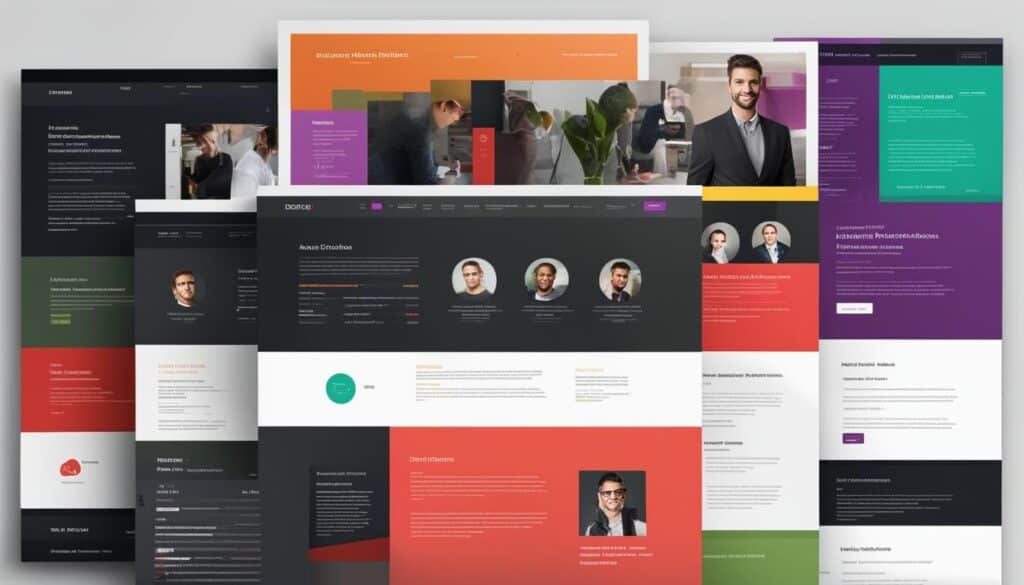
In this section, I will be exploring a variety of top portfolio website examples that showcase creativity, professionalism, and innovative design. These examples will serve as inspiration for individuals looking to create their own portfolio websites in various fields such as art, design, photography, and more.
When it comes to showcasing your skills, experience, and talent in today's digital age, having a well-designed portfolio website is essential. Whether you are an artist, designer, photographer, or any other creative professional, your portfolio website is your online showcase that can make a lasting impression on potential clients and employers.
Key Takeaways:
- Portfolio websites are crucial for creatives, designers, photographers, and artists.
- A well-designed portfolio website can leave a lasting impression on potential clients and employers.
- Innovative design, user-friendly layout, and effective presentation of projects are important elements of a portfolio website.
- Portfolio websites serve as inspiration for individuals looking to create their own professional and impactful online presence.
- When creating a portfolio website, consider the specific needs and requirements of your field.
Personal Resume Websites: Showcasing Skills and Experience
Personal resume websites have become increasingly popular for individuals looking to make a strong online presence and stand out in a competitive job market. These websites serve as a digital extension of an individual's resume, allowing them to highlight their skills, experience, and accomplishments in a customized and visually appealing manner.
Job seekers, freelancers, and professionals across various industries have embraced personal resume websites as a powerful tool for personal branding. By creating a website that showcases their professional journey, individuals can effectively communicate their unique value proposition to potential employers and clients.
Some key advantages of personal resume websites include:
- Customization: Personal resume websites provide the freedom to create a unique and personalized representation of one's skills and experience. This allows individuals to stand out in a sea of traditional resumes and make a memorable impression.
- Visual Appeal: With the ability to incorporate multimedia elements such as images, videos, and interactive design elements, personal resume websites offer a visually engaging experience for visitors.
- Flexibility: Unlike traditional paper resumes, personal resume websites can be easily updated and modified to reflect the most current information. This ensures that individuals can present themselves in the best possible light and adapt to changing career goals.
- Online Presence: In today's digital age, having a strong online presence is crucial. Personal resume websites not only showcase skills and experience but also demonstrate technological proficiency and an understanding of modern communication channels.
Overall, personal resume websites provide a dynamic and comprehensive platform for individuals to showcase their skills and experience. By leveraging the power of personal branding and effective design, these websites can make a lasting impression on potential employers and clients.

Table: Key Elements of a Personal Resume Website
| Key Element | Description |
|---|---|
| About Me Section | A brief introduction that highlights key strengths, goals, and values. |
| Experience Showcase | A section dedicated to showcasing past work experiences, projects, and achievements. |
| Skills and Expertise | A comprehensive list of skills and areas of expertise, highlighting the individual's unique capabilities. |
| Portfolio Gallery | A visually engaging gallery that showcases the individual's best work and projects. |
| Contact Information | Clear and prominent contact details, allowing potential employers and clients to easily get in touch. |
Creative and Professional Portfolio Websites
Portfolio websites play a crucial role in the creative industry, allowing individuals to showcase their work and skills to potential clients and employers. Whether you're a designer, photographer, or artist, having a well-designed portfolio website is essential for making a lasting impression. In this section, I will explore some of the top examples of creative and professional portfolio websites that stand out for their innovative design, user-friendly layouts, and effective presentation of projects.
Personal Portfolio Websites
Personal portfolio websites provide a platform for individuals to exhibit their unique style and creativity. One standout example is Alice Lee's portfolio website (image source: here). With a clean and minimalistic design, Alice's website showcases her artwork beautifully. The use of vibrant colors and organized layout creates an engaging visual experience for visitors. Another noteworthy personal portfolio website is Mike Kelley's (image source: here). With stunning photography displayed in a grid format, Mike's website captures the essence of his work and leaves a memorable impression on potential clients.
Professional Portfolio Websites
Professional portfolio websites are essential for individuals working in fields such as graphic design, web development, and architecture. Thomas Bosc's portfolio website (image source: here) is a prime example of a professionally designed website. The use of strong typography, sleek animations, and carefully curated project showcases Thomas' expertise and attention to detail. Renaud Rohlinger's portfolio website (image source: here) is another noteworthy example. With a focus on user experience and intuitive navigation, Renaud's website presents his projects in an organized and visually captivating manner.
By examining these personal and professional portfolio websites, we can gain valuable insights into effective design choices, layout structures, and project presentation techniques. These examples serve as inspiration for individuals looking to create their own standout portfolio websites that leave a lasting impression on potential clients and employers.
Conclusion
Creating a portfolio website is an important step in establishing a strong online presence and showcasing your skills, experience, and talent. Whether you are a job seeker, freelancer, or creative professional, a well-designed portfolio website can make a lasting impression on potential clients and employers.
The personal resume website examples and creative portfolio website examples presented in this article serve as inspiration for individuals looking to create their own professional and impactful online presence. These examples demonstrate the power of visual storytelling and effective presentation of work. By incorporating innovative design, user-friendly layouts, and compelling content, you can create a portfolio website that stands out from the competition.
Remember, your portfolio website is an opportunity to showcase your unique skills and abilities. Use it to highlight your best work, provide a glimpse into your creative process, and tell your professional story. With the right combination of design, content, and functionality, your portfolio website can become a powerful tool to attract potential clients, land new opportunities, and elevate your career.
FAQ
What are portfolio websites?
Portfolio websites are online platforms that showcase an individual's or a company's work, skills, and accomplishments. They are commonly used by creatives, designers, artists, photographers, and professionals to display their projects and attract potential clients or employers.
Why are personal resume websites important?
Personal resume websites are important because they provide a customized and visually appealing platform for individuals to highlight their skills, experience, and accomplishments. These websites help job seekers, freelancers, and professionals create a strong online presence and make a lasting impression on potential employers or clients.
How can personal resume websites benefit job seekers?
Personal resume websites can benefit job seekers by giving them a personalized platform to showcase their skills, experience, and achievements. These websites can help job seekers stand out from the competition, demonstrate their qualifications to potential employers, and provide additional information that may not be included in a traditional resume.
What should be included in a personal resume website?
A personal resume website should include relevant information such as a professional biography, resume, portfolio or samples of work, contact information, and links to social media profiles or professional networks. It should also have a visually appealing design, user-friendly navigation, and easy-to-find sections for different types of information.
How can portfolio websites benefit creatives and artists?
Portfolio websites benefit creatives and artists by providing a platform to showcase their work, attract potential clients or employers, and establish their brand. These websites allow artists to display their projects, share their artistic vision, and demonstrate their skills and talent to a wider audience.
What are the key elements of a successful portfolio website?
Some key elements of a successful portfolio website include an attractive and professional design, high-quality visuals that showcase the work effectively, a clear and intuitive navigation structure, concise and engaging project descriptions, and easy-to-find contact information or a way to get in touch with the artist or creative professional.
Can I use portfolio website templates?
Yes, using portfolio website templates is a convenient and time-saving option. There are numerous portfolio website templates available online that offer pre-designed layouts and customizable features. These templates can be a great starting point for creating your own portfolio website, allowing you to focus on the content and customization rather than starting from scratch.
How do I choose the right portfolio website template?
When choosing a portfolio website template, consider factors such as your industry or field, the type of content you want to showcase, the visual style you prefer, and the overall user experience provided by the template. It's important to select a template that aligns with your brand and allows you to present your work in the best possible way.
Are there any best practices for designing a portfolio website?
Yes, some best practices for designing a portfolio website include keeping the design clean and uncluttered, using high-quality images or videos, optimizing the website for different devices and screen sizes, organizing projects into logical categories or sections, including a clear call-to-action or contact form, and regularly updating the website with new projects or content.











